
A rolling utility table offers mobility and flexibility for varied tasks, while a stationary counter provides a fixed, sturdy workspace ideal for consistent use. Explore the benefits and drawbacks of each to determine the best fit for your workspace needs.
Table of Comparison
| Feature | Rolling Utility Table | Stationary Counter |
|---|---|---|
| Mobility | High - Equipped with wheels for easy movement | None - Fixed in one place |
| Use Cases | Flexible usage across rooms and tasks | Dedicated workspace or kitchen area |
| Space Efficiency | Compact and movable to save space | Requires permanent space |
| Weight Capacity | Typically lower; varies by model | Higher; designed for heavy loads |
| Installation | No installation required | Requires professional installation |
| Cost | Generally more affordable | Usually higher due to fixed structure |
| Maintenance | Easy to clean and maintain | May require upkeep of built-in fixtures |
Introduction: Rolling Utility Table vs Stationary Counter
Rolling utility tables provide versatile mobility and flexible workspace solutions, allowing easy repositioning in various environments such as kitchens, workshops, or offices. Stationary counters offer stable, fixed surfaces ideal for consistent tasks requiring durability and space efficiency, often found in commercial kitchens or retail settings. Choosing between the two depends on the need for portability versus a permanent, sturdy workspace.
Key Differences in Design and Mobility
A rolling utility table features wheels that provide high mobility, allowing you to easily move it across different spaces, while a stationary counter remains fixed and offers greater stability for heavy-duty tasks. The design of rolling utility tables typically includes locking casters to secure the table in place when needed, whereas stationary counters are built with heavier, more robust materials to support sustained weight and frequent usage. Mobility is the primary advantage of rolling utility tables, making them ideal for dynamic environments, whereas stationary counters excel in settings demanding consistent support and durability.
Space Efficiency and Storage Solutions
Rolling utility tables maximize space efficiency by offering mobile workspace options that can be easily repositioned or tucked away when not in use, unlike stationary counters that occupy a fixed area. These tables often include built-in storage such as shelves or drawers, enhancing organization and accessibility without requiring additional floor space. Your workspace benefits from the flexibility and compact storage solutions provided by rolling utility tables, especially in environments with limited room.
Versatility in Various Settings
Rolling utility tables offer unmatched versatility in various settings due to their mobile design, allowing easy relocation between rooms or workspaces. Stationary counters provide stable, fixed surfaces ideal for consistent tasks but lack the flexibility of movement. When your workspace demands adaptability and frequent reconfiguration, a rolling utility table enhances efficiency and convenience.
Durability and Longevity Comparison
Rolling utility tables feature heavy-duty steel frames and reinforced casters designed for frequent movement, providing robust durability under constant use. Stationary counters typically offer solid, fixed construction with materials such as stainless steel or thick wood, ensuring long-lasting performance without wear from mobility. The choice depends on whether sustained movement or static stability is prioritized, as rolling tables endure mechanical stress from transport while stationary counters withstand consistent workload without mobility-related wear.
Ease of Cleaning and Maintenance
Rolling utility tables offer superior ease of cleaning and maintenance due to their mobility, allowing you to access and sanitize all sides without difficulty. In contrast, stationary counters often restrict cleaning to accessible areas, potentially leading to dirt accumulation in hard-to-reach spaces. The smooth surfaces and sturdy materials typical of utility tables further simplify upkeep, ensuring a hygienic environment with minimal effort.
Cost Analysis: Investment and Value
Rolling utility tables often require a lower initial investment compared to stationary counters, making them budget-friendly for small businesses or temporary setups. Their mobility adds value by enabling flexible workspace configurations without the need for multiple fixed installations. Stationary counters, though typically more expensive upfront, offer greater durability and stability, potentially reducing long-term replacement costs and supporting heavy-duty use.
Safety Considerations and Stability
Rolling utility tables offer mobility but require locking mechanisms to ensure safety and prevent unexpected movement during use. Stationary counters provide inherent stability, reducing the risk of tipping or shifting under weight, which is crucial for tasks involving heavy equipment or precise work. Your workspace safety improves by choosing a stationary counter when stability is paramount, while locking rolling tables balance flexibility and secure positioning.
Aesthetic Impact on Interior Design
Rolling utility tables offer versatility and dynamic aesthetic appeal, seamlessly blending into various interior styles while providing functional mobility for your space. Stationary counters create a solid, anchored look that enhances structural design elements and adds a sense of permanence and organization. Choosing between the two depends on your need for flexibility versus a defined, cohesive visual impact in your interior design.
Final Verdict: Choosing the Right Surface
Rolling utility tables offer unmatched mobility and flexibility, ideal for dynamic workspaces or kitchens requiring frequent rearrangement. Stationary counters provide stability and durability, best suited for fixed setups where a solid surface is essential. Your choice depends on whether mobility or permanence better supports your workflow and space requirements.
 homyna.com
homyna.com